
image by Eugene Ipavec, 10 January 2008

Last modified: 2008-08-02 by dov gutterman
Keywords: italy | houseflag | house flag |
Links: FOTW homepage |
search |
disclaimer and copyright |
write us |
mirrors
See also:

image by Eugene Ipavec, 10 January 2008
The complete name of “Garibaldi” at Genoa was
‘SocietÓ Anonima Cooperativa di Navigazione
“Garibaldi” (i.e. Cooperative Shipping Company
“Garibaldi” Ltd). “Was” since I have the
impression this firm no longer exists – possibly succeeded
by ‘G.
Giuletti’ since 1995.
So we know that “Garibaldi” was founded by Captain
Giuseppe Giulietti in 1918; Our Spanish 1940 source shows a
(dark) blue flag bearing
a descending white diagonal. In 1936 the firm issued shares
showing the house flag
– as spotted on eBay on 7 Jan 2007 (item 230205442193 put up
by “montalpino”) with a slightly wider stripe or so it
seems.
Giulietti must have been quite a character – chairman of a
socialist seamen’s union; friend of Malatesta, the
anarchist; being involved in d’Annunzio’s Fiume
adventure, etc. A book on him (in Italian) at <www.tuttostoria.net>.
Jan Mertens, 10 January 2008

image by Eugene Ipavec, 11 November 2007
One of many flagoid sporting homepages is the one belonging to
the maritime Garolla Group, established at Naples at <www.sardabunkers.it>.
The following history page
gives us the essentials: Founded by Federico Garolla - a Genoan -
at Naples in 1870, as a bunkering and coal importing company
‘Ditta [Federico] Garolla”. Coal for the steamers was
brought from Great Britain, then distributed locally by tug-towed
barges. Sons and successors Roberto and Augusto bought a tanker
in 1927 to import oil from the Black Sea area, illustrating the
move from coal to oil driven ships.
After WWII the firm was renamed ‘Augusto Garolla &
Co.” (later named ‘Sarda Bunkers’), worked for
major suppliers such as Esso, Shell, and local
Agip. Bunkering activities expanded to Salerno and
Cagliari.
As evidenced by the homepage, Garolla is now technically a group
made up of ‘Sarda Bunkers’ which retains the bunkering
activity and ‘Med Offshore’ (the former
‘Vigliena’ taken over in 2004) which is an offshore
service provider operating supply vessels. The site’s
‘Fleet’ section offers many details as well as
clickable photos of most vessels.
A flag drawing is shown being identical for both companies.
Divided by a descending diagonal, red in the hoist and blue in
the fly which last bears a large white initial ‘G’
(serifed).
Jan Mertens, 9 November 2007
At the 1940 page at <www.24flotilla.com>:
‘Giovanni Gavarone’ at Genoa is the last of the fourth
(complete) row. The flag
is red and bears a large white initial ‘G’, serifed,
next to the hoist.
Besides Giovanni, a Giuseppe Gavarone is also found on the net:
sometimes “Fratelli Gavarone” are mentioned without
specifying whether these brothers formed a company or not.
In any case various ships have left their traces (many of
them sunk during WWII) and were in operation between 1913 and
1960 (first and last year as found). One example, the
‘Grazio Quarto’, appears at (see ‘G’ on
funnel): <www.agenziabozzo.it>.
Domenico Gavarone, perhaps related to the above, was a ship's
portrait artist active in Genoa (1840-75). This page
lists a number of this works: <www.fineartemporium.com>.
Jan Mertens, 10 April 2008

image by Eugene Ipavec, 19 february 2008
Above name, strictly speaking, is a short and easy way of
referring to an Italian fishery company represented in the 1940
Spanish house flag source (see fifth of first complete row,
between ‘Ligure’ and the ‘Ignazio Messina’
pennant). Full name was ‘Comp[agnia] Gen[erale] Italiana
della Grande Pesca" (i.e. General Italian Co. for Fishing on
the High Seas) based at Livorno (Leghorn).
House flag: Dark blue
field bearing an upright trident vertically divided green and
red, accompanied by or issuing from horizontally divided waves
green above white above red; in the upper hoist, a large yellow
initial ‘G’ without serifs. The use of the national
colours is evident, even more so if we include 'azzuro'.
This page (in
Italian) recounts the industrial beginnings of Giolfo &
Calcagno (Genoa/Livorno), pioneer sellers of frozen fish to the
Italian public: explaining the advantages of an Atlantic fishery
fleet – Genepesca, their supplier – and on board
freezing of catch.
Unilever took over Genepesca in 1968; used as a brand name, it
was as popular and well-known as nowadays Findus or Captain
Igloo.
Apparently a large ‘G’ and a trident, although less
striking than the one on the house flag, served as product
symbol.
Jan Mertens, 6 february 2008
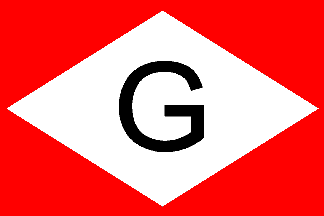
image by Jarig Bakker, 14 January 2005
Nav. Generale Gerolomich & Co., Trieste - red flag, white
diamond, black "G".
Source: Brown's Flags and Funnels of British and Foreign
Steamship Companies, compiled by F.J.N. Wedge, Glasgow, 1926 [wed26].
Jarig Bakker, 14 January 2005
At the 1940 page at <www.24flotilla.com>:
"Gerolemich", Genoa - The 1940 initial is green, our
1926 source gives a black one. I will have to come
back to this as the on-line 1912 Lloyds Flags & Funnels shows
the same pattern with, however, three black initials (and an
alternative name).
Jan Mertens, 5 January 2008
'Gerolimich & Co.' was an alternative name for
‘Nav[igazione] Gen[erale] Austriaca’ of NGA (see below)
as shown in the on-line 1912 Lloyds Flags & Funnels, no. 85,
first on this page: <www.mysticseaport.org>:
Red field with white diamond bearing black initials
‘NGA’, serifed.
Same firm, now using the family name only, in the 1940 source and
resembling the version above with a green initial ‘G’.
However, Wedge 1926 (see image
here) is right about the initial but not the colour – surely
the use of the national (Italian) colours is not a
coincidence.
Jan Mertens,6 January 2008
Nav. Gen. Austriaca

image by Ivan Sache, 24 March 2008
Lloyd's Book of House Flags and Funnels (1912) shows the house
flag of "Nav. Gen. Austriaca (Gerolimich & Co.)"
(#85, p. 41), a company based in Trieste (then in
Austria-Hungary), as red with a white diamond charged with the
black letters "NGA". The flag of "Nav. Generale
Gerolimich & Co." is of a similar pattern, but only with
"G". I guess that the "Austrian" epithet was
dropped from the company name after the First World War and,
accordingly, from the house flag. The company was subsequently
renamed "SocietÓ di Navigazione Generale Gerolimich".
Ivan Sache, 24 March 2008

image by Jorge Candeias, 24 Febuary 1999
Dark red over dark blue with a white stripe separating the two
main fields and a white "G" over all. The "G"
is very similar in shape to those of Grimaldi. Perhaps a member
of the Grimaldi Group?
Jorge Candeias, 24 Febuary 1999
From Fratelli Grimaldi formed in 1947 has come the Grimaldi Group operating in two divisions based
in Genoa and Naples respectively. Included in the former is
Gilnavi SocietÓ di Navigazione S.r.l. Indications are that the
various companies have differing liveries but in this case the
logo used appears to have come from the agency company Sealine
S.a.r.l.. whereas that indicated by the company website is for a
swallowtail horizontal biband of ordinary red over dark blue with
the white "G" as shown. This "G" format also
figures in some of the other liveries with a logo for Grimaldi
Group suggesting a dark blue swallowtailed flag with a white
"GG" on it, whilst Brown 1995 shows a blue ordinary
flag with a single white "G" for Grimaldi Compagnia di
Navigazione S.p.A. which appears to be a member of the Naples
division (company website) although itself based in Genoa
(according to Lloyds). Going by the funnel of the latter company
their shade of blue is lighter than the other variations.
Neale Rosanoski, 11 April 2003
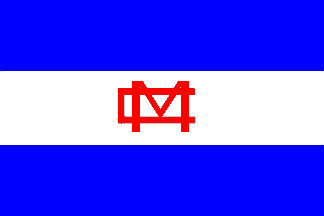
image by Jarig Bakker, 11 July 2004
At <www.omniainformatica.it>
there is an houseflag for
this company.
Jan Mertens, 31 October 2003
Horizontal BWB with in the center the company logo: capital M
superimposed by a long C, both red.
Jarig Bakker, 11 July 2004

image by Jarig Bakker, 11 July 2004
The flag of this company can be seen in the company site.
Dov Gutterman, 23 January 1999
Previous Flag (?)

image by Jarig Bakker, 10 December 2005
Grimaldi Compagnia di Navigazione S.p.A., Genoa - blue flag,
white italic "G" (just the one G, perhaps predecessor
of the one above with two G's).
Source: Brown's Flags and Funnels Shipping Companies of
the World, compiled by J.L. Loughran, Glasgow, 1995.
Jarig Bakker, 10 December 2005
The blue swallowtail with "GG" logo no longer
appears through the provided link as the Group has changed its
websites around. I have a download of the image on file but it is
insufficiently clear to definitely state that the
letters are as portrayed. I would tend to guess that they are
more likely to be in the flowing
style in line with the second flag [but more othodox] shown
by Jarig from Brown 1995 which is given as being for the
subsidiary Grimaldi Compagnia di Navigazione S.p.A. As
previously commented my guess is that the swallowtail
with the "GG" may have been a previous Group flag . It
is now replaced by a blue swallowtail
with a single white "G" for which a logo appears on
the current website <www.grimaldi.napoli.it>
though in both cases I doubt whether it was/is used as a sea
flag. The subsidiaries under which the shipping operate, with
ships interchangeable, all have their own funnel liveries and
perhaps their own flags. One definite flag is the recatangle of
Grimaldi Compagnia di Navigazione S.p.A. although the Brown
letter does not quite agree with the actual which I have taken
from a foto of a stem jack
worn by the "Grande Napoli". The "G" on
the flag is similar to that on the funnel but is more spread out,
presumably to occupy more of the flag field.
Neale Rosanoski, 6 February 2007

image by Ivan Sache, 24 March 2008
Lloyd's Book of House Flags and Funnels (1912) shows the house
flag of "Henry Piaggio" (#99, p. 41), a company based
in Genoa, as blue with a white diamond charged with the blue
letters R.G..
There is a Henry Piaggio mentioned as the owner of an Italian
American shipyard at Pascagoula, Texas. "Piaggio was born in
Italy (probably Genoa) on March 17, 1874, and was from a
prominent well-to-do family. He came to Pensacola,
Florida, as a teenager to work in and learn the sawmill and
lumber exporting business his father owned. He was
reported to have served in the U. S. Army during the Spanish
American War, although an extensive records search at the
National Archives, Washington, DC, failed to substantiate this.
In the early 1900s, Piaggio went to Gulfport and opened a lumber
export office. While traveling in Europe, Piaggio met Margret
Muldowned of Mt. Vernon, Ohio, in London, England. After they
married, they traveled to Russia and then returned to the United
States. Records indicated Piaggio was involved in exporting
timber in the early 1900s.
An insurance document was issued by the Maritime Insurance
Association of the Sea and Docks in Genoa, Italy. It was provided
by the Maritime Security Police for Cargo in the amount of
8,000,000 lira to insure cargo (probably timber) from Gulfport
and Ship Island, Mississippi, to Montevideo, Ecuador, and Buenos
Aires, Argentina. The date on the document was August
4, 1909, and the fee was 5.5 percent. Based on limited
information on Piaggio’s ships, the use of Italian insurers
seemed to be Piaggio’s policy."
That Piaggio dynasty started with the ship builder Rinaldo
Piaggio, whose name might have explained the "R" on the
house flag, but I have not found evidence that they were
subsequently involved in ship owning. The evidence reported
concerning Henry Piaggio is slim, too.
Source: <www.co.jackson.ms.us>.
Ivan Sache, 24 March 2008
For a few traces of Piaggio's - no Henry I believe - see Soc. Ligure di Armamento and Alta Italia.
Jan Mertens, 26 March 2008
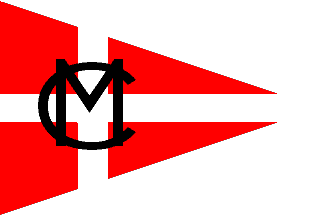
image by Jarig Bakker, 1 September 2005
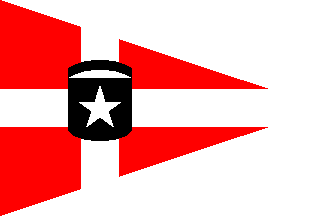
Variant ?
image by Jorge Candeias, 11 Febuary 1999
I believe that this is an italian company. The flag is a red
triangle with a white cross throughout and a black shield in the
center of the cross containing what seemed to be a 5-pointed
star. The original picture was too small, so I'm not at all sure
about the exact shape and charges of the shield (particularly the
shape above).
Jorge Candeias, 11 Febuary 1999
The company is based in Genoa, so it is Italian company. The
image is based on <www.informare.it>.
Dov Gutterman, 11 Febuary 1999
The company website shows an image of the houseflag being a
red pennent with a white cross surmounted by the black letter
logo "CM". The image displayed from the company website
has these letters replaced by a panel of the funnel i.e. black
with a white band above a white star. I can find nothing to
indicate that this is an actual flag or has replaced the other
and it appears to be merely a navigating button for their
website. The company have not responded to a query on this
matter.
Neale Rosanoski, 18 September 2002
Ignazio Messina & Cia., S.p.A., Genoa - red burgee, white
cross; in center intertwined "CM".
Source: Brown's Flags and Funnels Shipping Companies of
the World, compiled by J.L. Loughran, Glasgow, 1995.
Jarig Bakker, 1 September 2005
At the 1940 page at <www.24flotilla.com>:
"Ignazio Messina", Genoa - What we see is the variant
with initials, however the `C' encircles the `M'.
Jan Mertens, 8 January 2008

image by Antˇnio Martins-Tuvßlkin, 13 July 2008
Not much to be said on Ilva’s
house flag, fifth of second complete row in the 1940
Spanish source. It representing Soc[ietÓ] An[onima]
“Ilva” at Genova (i.e. Genoa): a pale blue swallowtail
with straight edges, completely bordered in white, a
white’$’ (dollar) sign in the centre.
What I take was the mother company, operating its own ships, is
presented at wikipedia.
Ilva (a family name but also ‘Elba’ in Latin) was the
name of a steel factory founded in 1905, at one point renamed
Italsider but now owned by the Riva Group.
Jan Mertens, 19 February 2008
I could add that the "$" dollar sign is of the
one-stroke sort and that the cut out seems to be orthogonal,
leaving the sign centered on the uncut area of the flag; the
fimbriation seems to be 1/10th of the flag height.
Researchers should broaden their prospective avenues to the
possiblity that this sign on this flag may have been influenced
not (only) by the U.S. or other dollars, but by the other
currencies that shared this sign at the time of the creation of
this flag.
Antˇnio Martins-Tuvßlkin, 13 July 2008
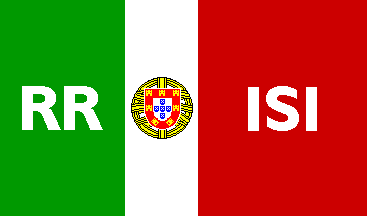
image by Jorge Candeias, 4 March 1999
Unequal vertical tricolour of green white and red. The green
stripe bears the initials "RR" in white, the white
stripe (the narrower) bears something very similar to the
portuguese Coat of Arms ,a yellow circular device with holes
charged by a white shield with red border. The original picture
was too small to see clearly, but something seemed to be in the
shield. The red stripe (the wider) bears the initials
"ISI" in white.
Jorge Candeias, 4 March 1999
Rimorchiatori Riuiti International Shipping & Investments
Ltda formed in 1999 is the full name being a subsidiary of the
Rimorchiatori Riuiti S.p.A. group through Portunato & Co.
S.r.l..
Neale Rosanoski, 11 April 2003
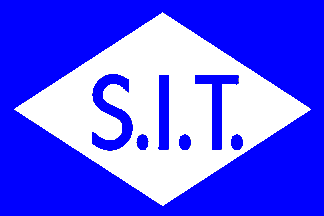
image by Jarig Bakker, 19 February 2005
Soc. di Nav. a Vap. Istria, Trieste - blue flag, white
diamond, blue "S.I.T.".
Source: Brown's Flags and Funnels of British and Foreign
Steamship Companies, compiled by F.J.N. Wedge, Glasgow, 1926 [wed26]
Jarig Bakker, 19 February 2005
At the 1940 page at <www.24flotilla.com>:
"Istria", Trieste - Serifed initials; the diamond
touches the flag's edges. Company name (without `Vapore' which
may be a variant): `SocietÓ Anonima di Navigazione
Istria-Trieste' indicating where the flag's initials came
from. Different kind of blue probably is not
significant here.
Jan Mertens, 8 January 2008

image by James Dignan , 13 December 1997
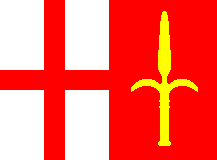
"Italian Line" (probably wrong)
image by Al Fisher , 1 Febuary 1999
Houseflag of "Italia" Societa Anonima di
Navigazione.
James Dignan, 13 December 1997
"Italia di Navigazione Srl" is one of the partners
in MPE.
Dov Gutterman, 31 July 1999
Stewart shows spear as being white.
Al Fisher, 1 Febuary 1999
Italia di Navigazione Srl and the Italian Line are one and the
same. Originating 1932 as Italia Flotte Riunite it was part of
the 1936 Italian Government reorganisation becoming from 1.1.1937
SocietÓ per Azione di Navigazione Italia and eventually ended
as Italia di Navigazione S.p.A. The flag combines those of
Genoa and Trieste with the latter emblem being a
"ranseur" or spear head. No other source suggests that
the spear was ever yellow.
Neale Rosanoski, 11 April 2003
Due to the 'thirties Depression, various Italian shipping
companies were united into a big concern. From The Ships
List, an overview <www.theshipslist.com>:
"In 1932, due to the depression and widespread unemployment
of Italian ships, the major Italian shipping companies were
combined into one state controlled syndicate under the name
Societa Italia Flotte Reuniti NGI - Lloyd Sabaudo - Cosulich. By
1937 this concern had made rapid recovery and repaid the
Government bonds which had supported it. It was then changed into
a Limited Company under the name Italia Societa Anonima di
Navigazione. Lloyd Triestino was incorporated into the new
company. A new holding company (FINMARE) was formed and created
four self contained shipping companies:
ADRIATICA based in Trieste to serve the Adriatic and comprised
Adriatica di Nav., Fiumana and Lloyd Triestino's local services.
TIRRENIA based in Naples served the Tyrrhenian Sea and comprised
Adria, Tirrenia and Sarda.
LLOYD TRIESTINO based Genoa which covered Africa and the Far
East. Comprised Lloyd Triestino, Libera Triestina, Italia Flotte
Reuniti's non North and South American routes plus Veneziana.
ITALIA to cover North and South America and comprised Italia
Flotte Reuniti, Cosulich, Libera Triestina and Veneziana.
In 1940 most Italian ships were taken over for military service
and by 1945, few were left afloat. The fleet was gradually
rebuilt but from 1960 the rising popularity of air travel
signalled the gradual decline of the passenger ships and they
were eventually switched to cruising. By 1977 all long distance
passenger travel had ceased, although many cargo ships continued
to carry a few passengers. A cruising company was set up (Italia
Crociere Internazionali) to employ the remaining passenger
vessels but ceased trading in 1980. Italia continued as a
freighting company, mostly with second hand or chartered
container ships and still operates, but in private
ownership."
Jan Mertens, 29 December 2003

image by Jarig Bakker, 19 August 2004
From the link provided by Barbara Tomlinson of The National
Maritime Museum <www.nmm.ac.uk>:
"The house flag of the Italia Societa Anonima di
Navigazione, Genoa. In this example the design appears to be
reversed. It combines the St George's Cross of Genoa with the
arms of Trieste, represented by a white halberd on a red field.
The flag is made of a wool and synthetic fibre bunting with a
linen hoist. It is machine sewn and the design is printed. A rope
is attached. The major Italian shipping lines were
nationalized under the holding company, Societa Finanziaria
Industriale Italiana in 1932 as a result of the depression. In
1936 the fleet was split into four divisions each serving an
agreed geographical area. Italia commenced operations the
following year on routes to North and South America. By the end
of the 1960s Italia's prestigious passenger liners were becoming
unprofitable owing to the competition from air transport and the
company switched its operations to freight. It is now in private
ownership as part of the Fratelli D'Amico Armatori Societa per
Azioni, Genoa."
It is possible that the Museum got it wrong, as it seems to be
the flag of Lloyd Triestino...
Jarig Bakker, 19 August 2004
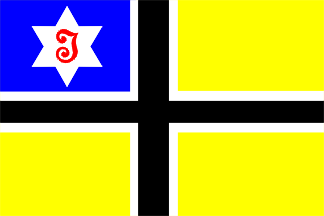
image by Jarig Bakker, 30 October 2006
From <www.timetableimages.com>:
'Italia' SocietÓ di Navigazione a Vapore, Genoa. As it happens,
the on-line 1912 Lloyds Flags & Funnels has a nice clear
picture i.e. No. 1197 on (the electronic) p. 58 at <www.mysticseaport.org>:
yellow, a black cross throughout, a blue canton bearing a white
six-pointed star which in its turn bears what appears to be a red
mirrored figure '6'. Then, of course, it may well be a
handwritten uppercase 'I'. The card on <planeta.terra.com.br>,
however, shows a fimbriated cross.
More on this firm at planeta
site: founded in 1899 but under the control of the German
Hamburg-America Line which then (1906) moved to the Navigazione
Generale Italiana; becoming a de facto branch of this firm in
1917, sharing its fortunes from then on.
Jan Mertens, 14 July 2004
Italia SocietÓ di Navigazione Ó Vapore - Bonsor describes
the flag as having a blue cross so if it were a dark blue shade,
as also with the canton, it would fit in with the planeta site
image where the two do seem to be a similar colour and it would
explain the fimbriation of the cross. Bonsor calls the letter an
"I" which has to logical though it reminds me more of a
written "T", and makes no mention of the Lloyds
version.
Neale Rosanoski, 22 July 2004
There remains some doubt about the colour of the cross, and
whether it is fimbriated or not. See the picture at <www.civilization.ca>
showing the ship `Ancona' and some flags, the biggest of them representing
the company.
To my mind, the canton is blue, but the cross is black (and
fimbriated), the initial "I" is rather elaborate,
compare the capital letter to the right of the house flag. This
does not explain the choice of colours. (The six-pointed star
could be a variant of the five-pointed one which is one of
Italy's symbols, or even have a religious significance).
Jan Mertens, 30 October 2006
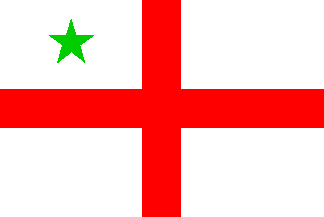
image by Ivan Sache, 25 March 2001
The houseflag of the Italian shipping company 'Italian
Transporti Maritimi' is a white field with a St. George's cross
and a green star in canton. I suspect the company is (or was
originally) based in Genoa because of the St. George's cross.
Source: Znamierowski [zna00],
p. 245.
Ivan Sache, 25 March 2001
Full name is Compagnia Italiana Transporti Marittima S.A. and
it was based Genoa. Known as CITMAR it appears to have
ceased trading in the early 1970s.
Neale Rosanoski, 11 April 2003
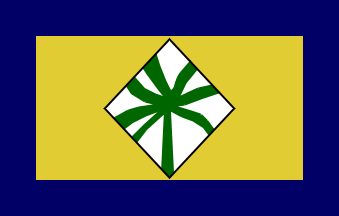
image by Eugene Ipavec, 27 January 2008
The top right house flag
of the 1940
Spanish source is the one representing the Italian company
Italo-Somala, based at Genoa: it is yellow with a wide dark blue
border (most instances of blue are rendered very dark in this
chart) and bears a white diamond in the centre, the upper and
lower edges of which touch the border; on the diamond is a green
palm tree.
The following text from <countrystudies.us>
describes pre- and post-WWII economic conditions in Italian
Somaliland, as it was once called, for instance the plantation
system introduced from 1920 on by the ‘SocietÓ Agricola
Italo-Somala’ (SAIS) i.e. Italo-Somali Agricultural Company:
Bananas, cotton, and sugarcane were grown but not all were
successful.
The list at <digilander.libero.it>
mentions a bibliography by Ernesto Milanese giving the dates
1921-1939 for the firm.
I have found no clear link with ‘SocietÓ Anonima di
Navigazione Italo-Somala’ (Genoa) which may have been the
shipping department of above firm or may have simply borne the
same name. Following text charts the career of the Duke of the
Abruzzi, a royal prince who was – among other things –
a famous mountain climber in his day and the driving force behind
SAIS: <www.vqronline.org>.
Jan Mertens, 22 January 2008